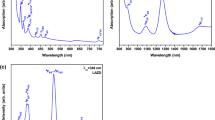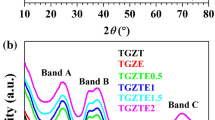Abstract
The photoluminescence (PL) properties of singly doped (Dy3+) and codoped (Dy3+, Eu3+) fluoroaluminoborate glasses, with an emphasis on the white light generation, are studied. The γ-irradiation led to the formation of defects in Dy3+-doped glasses and photoreduction of Eu3+ to Eu2+ in codoped (Dy3+, Eu3+) glasses. The electron paramagnetic resonance spectra confirm the presence of divalent europium ions and defects in Dy3+, Dy3+–Eu3+-doped glasses. The FTIR spectra mainly establish the compaction of glass network due to γ-irradiation. From the PL spectra, the intensity ratio of Dy3+ emission bands yellow to blue (4F9/2–6H13/2/4F9/2–6H15/2) defines the site symmetry, covalency, and feasibility of extracting white light. The existence of an energy transfer (ET) from Dy3+ to Eu3+ ions are established due to the decrease in intensity of Dy3+ peaks with an increase of Eu2O3 content. Moreover, the non-exponential nature of decay curves was well fitted with the generalization of Yokota–Tanimoto model for electric dipole-quadrupole (S = 8) interaction that is responsible for ET process from sensitizer (Dy3+) to activator (Eu3+).











Similar content being viewed by others
References
Kaur P, Kaur S, Singh GP, Singh DP (2014) Cerium and samarium codoped lithium aluminoborate glasses for white light emitting devices. J Alloys Compd 588:394–398
Liu S, Zhao G, Ying H, Wang J, Han G (2008) Eu/Dy ions co-doped white light luminescence zinc–aluminoborosilicate glasses for white LED. Opt Mater 31:47–50
Amarnath Reddy A, Chandra Sekhar M, Pradeesh K, Surendra Babu S, Vijaya Prakash G (2011) Optical properties of Dy3+–doped sodium–aluminum–phosphate glasses. J Mater Sci 46:2018–2023
Kesavulu CR, Jayasankar CK (2011) White light emission in Dy3+–doped lead fluorophosphate glasses. Mater Chem Phys 130:1078–1085
Dwivedi Y, Thakur SN, Rai SB (2007) Study of frequency upconversion in Yb3+/Eu3+ by cooperative energy transfer in oxyfluoroborate glass matrix. Appl Phys B 89:45–51
Shan Z, Chen D, Yu Y, Huang P, Lin H, Wang Y (2010) Luminescence in rare earth-doped transparent glass ceramics containing GdF3 nanocrystals for lighting applications. J Mater Sci 45:2775–2779
Tang L, Xia HP, Wang PY, Peng JT, Zhang YP, Jiang HC (2013) Preparation and luminescence characteristics of LiYF4:Tm3+/Dy3+ single crystals for white-light LEDs. J Mater Sci 48(21):7518–7522. doi:10.1007/s10853-013-7566-4
Wu L, Zhang Y, Gui M, Lu P, Zhao L, Tian S, Kong Y, Xu J (2012) Luminescence and energy transfer of a color tunable phosphor: Dy3+–Tm3+–and Eu3+–coactivated KSr4(BO3)3 for warm white UV LEDs. J Mater Chem 22:6463–6470
Zhu G, Ci Z, Xin S, Wen Y, Wang Y (2013) Warm white light generation from Dy3+ doped NaSr2Nb5O15 for white LEDs. Mater Lett 91:304–306
Mohan Babu A, Jamalaiah BC, Suresh Kumar J, Sasikala T, Rama Moorthy L (2011) Spectroscopic and photoluminescence properties of Dy3+ doped lead tungsten tellurite glasses for laser materials. J Alloys Compd 509:457–462
Jayasimhadri M, Rama Moorthy L, Kojima K, Yamamoto K, Wada N, Wada N (2006) Optical properties of Dy3+ ions in alkali tellurofluorophosphate glasses for laser materials. J Phys D Appl Phys 39:635–641
Dorosz D, Zmojda J, Kochanowicz M (2014) Broad band near-IR emission in glass codoped with rare earth ions. SPIE Newsroom. doi:10.1117/2.1201404.005415
Venkateswara Rao G, Yadagiri Reddy P, Veeraiah N (2002) Thermoluminescence studies on Li2O–CaF2–B2O3 glasses doped with manganese ions. Mater Lett 57:403–408
Palik (eds) (1997) Handbook of Optical Constants. Academic Press, Orlando vol 3, ISBN 0-12-544423-0
Hari Babu B, Ravi Kanth Kumar VV (2012) Fluorescence properties and electron paramagnetic resonance studies of γ-irradiated Sm3+–doped oxyfluoroborate glasses. J Appl Phys 112:093516
El-Batal HA, Azooz MA, Ezz-El-Din FM, El-Alaily NA (2001) Interaction of gamma rays with calcium aluminoborate glasses containing holmium or erbium. J Am Ceram Soc 84:2065–2072
Liu Y, Zhu B, Wang L, Qiu J, Dai Y, Ma H (2008) Femtosecond laser induced coordination transformation and migration of ions in sodium borate glasses. Appl Phys Lett 92:121113
Martin LL, Gonzalez PH, Martin IR, Puerto D, Solis J, Caceres JM, Capuj NE (2010) Local devitrification of Dy3+ doped Ba2TiSi2O8glass by laser irradiation. Opt Mater 33:186–190
Hari Babu B, Ravi Kanth Kumar VV (2013) Photoluminescence properties of Tb–Eu–Mn–codoped fluoroborate glasses under γ-irradiation. J Appl Phys 114:123512
Hari Babu B, Ravi Kanth Kumar VV (2014) Photoluminescence and color tunability of-irradiated Tb3+–Sm3+–codoped oxyfluoride aluminoborate glasses. J Mater Sci 49:415–423
Singh D, Singh K, Bajwa BS, Mudahar GS, Singh DP, Manupriya MA, Dangwal VK (2008) Optical and structural properties of Li2O–Al2O3–B2O3 glasses before and after γ-irradiation effects. J Appl Phys 104:103515
Kaur P, Singh GP, Kaur S, Singh DP (2012) Modifier role of cerium in lithium aluminium borate glasses. J Mol Struct 1020:83–87
Jiao Q, Yu X, Xu X, Zhou D, Qiu J (2013) Relationship between Eu3+ reduction and glass polymeric structure in Al2O3-modified borate glasses under air atmosphere. J Solid State Chem 202:65–69
Sharma G, Singh K, Manupriya MS, Singh H, Bindra S (2006) Effects of gamma irradiation on optical and structural properties of PbO–Bi2O3–B2O3 glasses. Radiat Phys Chem 75:959–966
Lavin V, Babu P, Jayasankar CK, Martin IR, Rodriguez VD (2001) On the local structure of Eu3+ ions in oxyfluoride glasses. Comparison with fluoride and oxide glasses. J Chem Phys 115:10935–10944
Sundara Rao M, Sudarsan V, Brik MG, Gandhi Y, Bhargavi K, Piasecki M, Kityk IV, Veeraiah N (2013) De-quenching influence of aluminum ions onY/B ratio of Dy3+ ions in lead silicate glass matrix. J Alloys Compd 575:375–381
Sole JG, Bausa LE, Jaque D (2005) Wiley, New York
Chung WJ, Heo J (2001) Room temperature persistent spectral hole burning in x-ray irradiated Eu3+–doped borate glasses. Appl Phys Lett 79:326–328
Pisarska J (2009) Optical properties of lead borate glasses containing Dy3+ ions. J Phys 21:285101–285106
Shanmugavelu B, Ravi Kanth Kumar VV (2014) Luminescence studies of Dy3+ doped bismuth zinc borate glasses. J Lumin 146:358–363
Linganna K, Srinivasa Rao Ch, Jayasankar CK (2013) Optical properties and generation of white light in Dy3+ doped lead phosphate glasses. J Quant Spectrosc Radiat Transf 118:40–48
Inokuti M, Hirayama F (1965) Influence of energy transfer by the exchange mechanism on donor luminescence. J Chem Phys 43:1978–1989
Yokota M, Tanimoto O (1967) Effects of diffusion on energy transfer by resonance. J Phys Soc Jpn 22:779–784
Martin IR, Rodriguez VD, Rodriguez-Mendoza UR, Lavin V, Montoya E, Jaque D (1999) Energy transfer with migration. Generalization of the Yokota–Tanimoto model for any kind of multipole interaction. J Chem Phys 111:1191–1194
Wang J, Ning G, Gong W, Ye J, Lin Y (2011) Synthesis and luminescence properties of a novel Eu3+, Tb3+ co-doped Al18B4O33 whiskers by a gel nano-coating method. J Mater Sci 46:1259–1263
Culea E, Simiti IV, Borodi G, Culea EN, Stefan R, Pascuta P (2014) Structural and spectroscopic effects of Ag–Eu3+ codoping of TeO2–PbO glass ceramics. J Mater Sci 49:4620–4628
Liu S, Zhao G, Ruan W, Yao Z, Xie T, Jin J, Ying H, Wang J, Han G (2008) Reduction of Eu3+ to Eu2+ in aluminoborosilicate glasses prepared in air. J Am Ceram Soc 91:2740–2742
Fan S, Yu C, He D, Wang X, Hu L (2012) Tunable white light emission from γ-irradiated Ag/Eu co-doped phosphate glass phosphor. Opt Mater Express 2:765–770
Das S, Amarnath Reddy A, Surendra Babu S, Vijaya Prakash G (2011) Controllable white light emission from Dy3+–Eu3+ co-doped KCaBO3 phosphor. J Mater Sci 46:7770–7775
Wang C, Peng M, Jiang N, Jiang X, Zhao C, Qiu J (2007) Tuning the Eu luminescence in glass materials synthesized in air by adjusting glass compositions. Mater Lett 61:3608–3611
Duffy JA (1989) A Common optical bascitity scale for oxide and fluoride glasses. J Non-Cryst Solids 109:35–39
Xu B, Tan D, Zhou S, Hong Z, Sharafudeen KN, Qiu J (2012) Enhanced broadband near-infrared luminescence of Bi-doped oxyfluoride glasses. Opt Express 20:29105–29110
Rodriguez CP, McCloy JS, Schweiger MJ, Crum JV, Winschell A (2011) Optical basicity and nepheline crystallization in high alumina glasses. Pacific Northwest National Laboratory Richland, Washington 99354, PNNL20184, EMSP-RPT-003
Paulose PI, Jose G, Thomas V, Unnikrishnan NV, Warrier MKR (2003) Sensitized fluorescence of Ce3+/Mn2+ system in phosphate glass. J Phys Chem Solids 64:841–846
McCamy CS (1992) Correlated color temperature as an explicit function of chromaticity coordinates. Color Res Appl 17:142–144
Fred Schubert F(2006) Light emitting diodes (Chapter 17), 2nd edn. Cambridge University Press, Cambridge
Acknowledgements
The authors would like to acknowledge the central instrumentation facility (CIF), Pondicherry University and University Grants Commission, New Delhi, India for financial support in the form major research Project (No. 39-472/2010). The authors are also thankful to the Sophisticated Analytical Instrument Facility (SAIF), Indian Institute of Technology, Chennai for providing EPR facility.
Author information
Authors and Affiliations
Corresponding author
Rights and permissions
About this article
Cite this article
Hari Babu, B., Ravi Kanth Kumar, V.V. Photoluminescence properties and energy transfer in γ-irradiated Dy3+, Eu3+-codoped fluoroaluminoborate glasses. J Mater Sci 49, 7959–7969 (2014). https://doi.org/10.1007/s10853-014-8486-7
Received:
Accepted:
Published:
Issue Date:
DOI: https://doi.org/10.1007/s10853-014-8486-7




